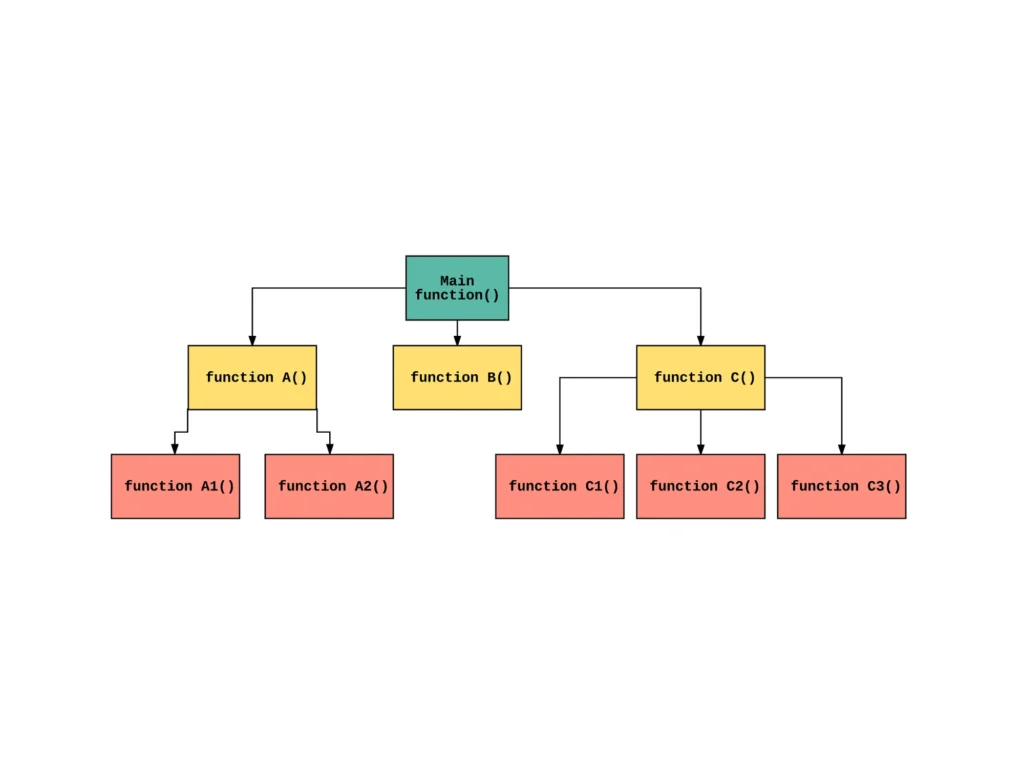Functional programming (FP) is a programming paradigm where programs are constructed by applying and composing functions. Unlike object-oriented programming (OOP) or procedural programming, FP focuses on the use of pure functions, immutability, and the avoidance of side effects. It provides a different way of thinking about problem-solving and is particularly useful in applications that require concurrency, parallelism, and predictable behavior.
1. Core Principles of Functional Programming
1.1 Pure Functions
A pure function is a function that:
- Always returns the same result for the same input.
- Has no side effects (i.e., it doesn’t modify any external state or rely on external variables).
For example:
// Pure function
function add(a, b) {
return a + b;
}The function add always returns the same result for given inputs, and it doesn’t alter any external data.
1.2 Immutability
In FP, data is immutable, meaning it cannot be changed once created. Instead of modifying data, you create a new copy with the desired changes. This reduces errors caused by unintended side effects and makes programs more predictable.
Example of immutable data in JavaScript:
const person = { name: 'John', age: 25 };
// Create a new object instead of modifying the original
const olderPerson = { ...person, age: 26 };1.3 First-Class and Higher-Order Functions
In FP, functions are first-class citizens, meaning they can be passed as arguments, returned as values, and stored in variables.
- First-Class Functions: Functions can be treated like any other variable.
const greet = function(name) {
return `Hello, ${name}`;
};- Higher-Order Functions: Functions that take other functions as arguments or return them as results.
function applyOperation(operation, a, b) {
return operation(a, b);
}
const result = applyOperation((x, y) => x + y, 5, 3); // result is 81.4 Function Composition
Function composition is the process of combining two or more functions to produce a new function. In FP, small functions are composed to build more complex behavior.
For example, composing two functions:
const toUpperCase = str => str.toUpperCase();
const exclaim = str => `${str}!`;
const shout = str => exclaim(toUpperCase(str));
console.log(shout("hello")); // Outputs: HELLO!1.5 Declarative vs. Imperative Code
- Imperative programming involves writing code that describes how to do something (step-by-step instructions).
- Declarative programming describes what should be done (focus on the result, not the process).
FP encourages a declarative style of programming, making the code more concise and easier to reason about.
Example:
// Imperative (how to do it)
let numbers = [1, 2, 3, 4];
let doubled = [];
for (let i = 0; i < numbers.length; i++) {
doubled.push(numbers[i] * 2);
}
// Declarative (what to do)
let doubled = numbers.map(n => n * 2);2. Key Concepts in Functional Programming
2.1 Higher-Order Functions (HOFs)
Higher-order functions are a foundational concept in FP. They take functions as input and return new functions as output.
Some common HOFs in JavaScript include:
- map(): Transforms an array by applying a function to each element.
const numbers = [1, 2, 3, 4];
const doubled = numbers.map(num => num * 2); // [2, 4, 6, 8]- filter(): Filters elements in an array based on a condition.
const evens = numbers.filter(num => num % 2 === 0); // [2, 4]- reduce(): Reduces an array to a single value by accumulating results.
const sum = numbers.reduce((acc, num) => acc + num, 0); // 102.2 Recursion
Recursion is a technique where a function calls itself to solve smaller instances of the same problem. In FP, recursion is often used instead of loops to iterate over data structures.
Example:
function factorial(n) {
return n === 0 ? 1 : n * factorial(n - 1);
}2.3 Currying
Currying is the process of transforming a function that takes multiple arguments into a series of functions that take one argument at a time.
Example:
function multiply(a) {
return function(b) {
return a * b;
};
}
const double = multiply(2);
console.log(double(5)); // 10Currying allows for more flexible function composition and reusability.
2.4 Lazy Evaluation
Lazy evaluation delays the computation of values until they are actually needed. This can improve performance by avoiding unnecessary calculations.
Example in JavaScript using generators:
function* generateNumbers() {
let i = 0;
while (true) {
yield i++;
}
}
const numbers = generateNumbers();
console.log(numbers.next().value); // 0
console.log(numbers.next().value); // 13. Functional Programming in Popular Languages
Many modern programming languages support functional programming features, including:
- JavaScript: Provides first-class functions, HOFs, and supports functional paradigms.
- Python: Includes map, filter, lambda functions, and more functional programming tools.
- Haskell: A purely functional language designed specifically for FP.
- Scala: Combines functional and object-oriented programming.
- Clojure: A functional dialect of Lisp, designed for concurrency and immutability.
4. Benefits of Functional Programming
- Easier Debugging and Testing: Since pure functions don’t have side effects and rely only on their inputs, they are easier to test.
- Concurrency: Immutable data structures and pure functions make functional programming suitable for concurrent and parallel processing.
- Code Reusability: Small, composable functions increase code reuse.
- Predictable Behavior: FP ensures that the same inputs always result in the same outputs, making programs more predictable.
5. Conclusion
Functional programming offers a unique and powerful way to approach problem-solving, particularly when dealing with complex systems, concurrency, or parallel tasks. By leveraging pure functions, immutability, and higher-order functions, developers can build more predictable, testable, and maintainable software.
At TechsterTech.com, we utilize functional programming techniques to deliver high-quality, efficient software solutions. Our team is well-versed in modern programming paradigms, ensuring the best outcomes for your projects.



